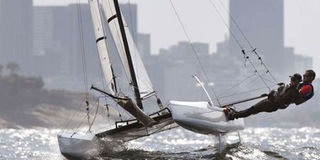Lo and behold, the vast River of January

Spain's Nacra 17 sailing class competitors Tara Pacheco and Fernando Echavarri take part in a training session in Rio de Janerio's Guanabara Bay ahead of the 2016 Rio Olympic Games on August 4, 2016. PHOTO | WILLIAM WEST |
What you need to know:
- Cable cars take you up and down the mountain tops and between mountains.
- High up in the cars, you have a commanding view of Guanabara Bay, where the Olympic sailing competition will take place.
I live on a street called Rua Dona Marianna. It connects two major thoroughfares, Rua Sao Clemente and Rua Voluntarios.
Further down both Rua Sao Clemente and Rua Voluntarios and forming a huge rectangular block is a street with an iconic name: Rua Nelson Mandela. It is there where you board or disembark the Botafogo underground. To the end of Rua Voluntarios is Botafogo beach, sandwiched between rocky mountains.
Cable cars take you up and down the mountain tops and between mountains. High up in the cars, you have a commanding view of Guanabara Bay, where the Olympic sailing competition will take place.
You can see most of the landmarks of Rio, the statue of Christ the Redeemer and the mountains jutting out of the sea. The view is staggering. This city is insanely beautiful and every day I wonder about the volcanic dance and fireworks that took place here eons ago to create it. It doesn’t seem to me that such movements of the earth, when they were finally done, left anything that could be improved on.
Guanabara is a vast body of water from which the city takes its name. The first Portuguese explorers, who arrived here in the month of January, mistakenly thought that they were seeing the estuary of a huge river. So they called the place River of January (Rio de Janeiro). The misnomer has lived through time.
Rua Dona Marianna is located in an upper middle class neighbourhood. From end-to-end, the street is covered by a canopy of mature trees. Every day, people walk their different breed of dogs in the street and throughout the neighbourhood. There are pigeons everywhere and they hop just enough from your feet to let you walk.
Early in the mornings, I go to Botafogo beach to jog in the sands in preparation for my working day. It is a stress-free walk, to and from the Casa house.
When crossing the road, you just wait for the vehicle traffic light to turn red and the pedestrian walking light to turn green. There is no matatu or boda boda motor bike to zoom past as if no rules exist.
Everybody obeys the lights and it shocks me, and fills me with despair, that such a common sense activity can be the subject of a writing topic because of its rarity in Nairobi.
But even this placid neighbourhood startled me the other day. I was heading towards Rua Nelson Mandela when I almost collided with a man pulling a mkokoteni laden with cement. I pulled aside in the nick of time. I looked back at him and evaluated his mkokoteni. By shape and aerodynamic integrity, I gave it a 20 per cent improvement on the ones that ferry farm produce in Marikiti.
But I still wondered how he brakes it; ours have a huge tyre beneath the rear frame and the “driver” simply releases his handle upwards and the cart drags itself to a stop.
Anyway, as he disappeared towards wherever he was going, I prayed that I do not run into a boda boda speeding in the opposite direction to traffic. I crave a stress-free existence, especially when it is not rocket science involved.





